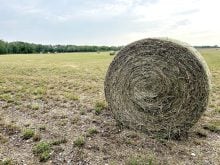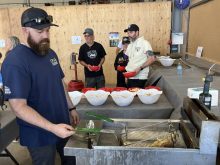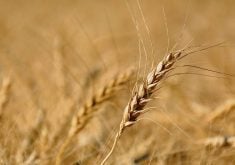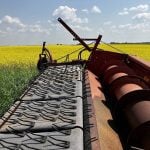While generally in Alberta, insect populations are lower than in previous years, there are some watch areas and some insect pests that will be of concern in the coming growing season.
“Weather is always the driving factor for insect populations. However, it is anticipated that Alberta will experience low numbers of many of the usual insect pests in 2010,” says Scott Meers, insect management specialist with Alberta Agriculture and Rural Development.
At the recent Agronomy Update, Meers shared a few forecast statements on some of Alberta’s most common insect pests:
Read Also

Hail research hopes to benefit potato growers
Alberta research scientist measures hail storm and heat dome affects on potato crops
Cabbage seedpod weevil. Slightly enhanced populations may be seen this year, but in the traditional range and locations. Producers who have been dealing with this pest, will need to monitor their fields again in 2010.
Wheat midge. The forecast for 2010 is for quite low populations. It’s not gone, but the population is much lower than in previous years.
Pea leaf weevil. It is expected that 2010 will see higher populations, especially if spring weather conditions are favourable for this pest. There has been no expansion in pea leaf weevil range in the past two years.
Grasshoppers. There are a few extreme hot spots in the Peace and Northwest Alberta and a few areas of potential problems in the Special Areas and in the Taber area. Grasshoppers are a very weather-driven pest. Warm, dry conditions favour the grasshopper and cool, wet conditions do not.
Wheat stem sawfly. The trend over the last four to five years has been that population numbers have gone back to traditional levels. There are still pockets of concern in the south part of the province where there are substantial population numbers and if Alberta experienced a series of dry years, this pest would make a resurgence.
Bertha army worm. The coming season will likely see very low numbers of this pest and there is really no reason to suspect an outbreak this year. Even though populations were at the low end in 2009 and are expected again, the monitoring program for this pest will continue.
“Cereal leaf beetle has the ability to be damaging in all cereal crops, and may be the next insect problem Alberta producers see,” says Meers. “Experience in other parts of North America has shown oats as the preferred crop. In southern Alberta, however, there are very few oat crops and the highest populations have been found in winter wheat. This insect is a pest of interest that we will be monitoring.”
Producers are encouraged to visit Alberta Agriculture’s website for full information on insect forecasts and to continue to monitor the website for updates to information and maps as the 2010 growing progresses. The maps are easy to use and, during the growing season, are updated in real time, which gives Alberta producers access to the most current information possible.














